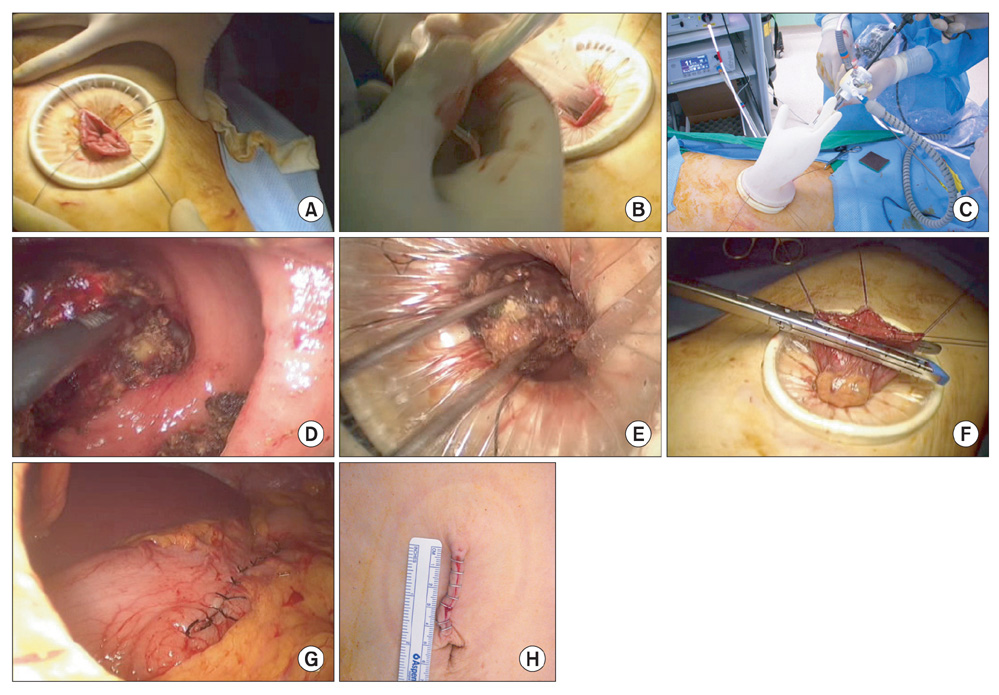J Gastric Cancer.
2011 Dec;11(4):230-233.
New Surgical Approach for Gastric Bezoar: "Hybrid Access Surgery" Combined Intragastric and Single Port Surgery
- Affiliations
-
- 1Department of Surgery, Yonsei University College of Medicine, Seoul, Korea. wjhyung@yuhs.ac
- 2Robot and MIS Center, Yonsei University College of Medicine, Seoul, Korea.
- 3Brain Korea 21 Project for Medical Science, Yonsei University College of Medicine, Seoul, Korea.
- 4Department of Surgery, Fujita Health University, Toyoake-shi, Aichi, Japan.
- 5Department of Surgery, College of Physicians and Surgeons, Columbia University, New York, NY, USA.
Abstract
- Regarding the removal of a gastric bezoar, laparoscopic surgery was performed and it was shown that the laparoscopic approach is safe and feasible. However, the laparoscopic method has the risk of intraabdominal contamination, when the gastric bezoar is retrieved from the gastric lumen in the peritoneal cavity. We developed and applied a new procedure for the removal of the gastric bezoar using one surgical glove and two wound retractors as a fashion of intragastric single port surgery. Herein we present this new minimal invasive procedure, so named "hybrid access surgery" which involves the use of existing devices and overcomes the weakness of laparoscopic removal of the gastric bezoar. Our new procedure, combining the concept of intragastric and single port access, is acceptable and feasible to retrieve the gastric bezoar. In the future, this procedure may be one of the alternative procedures for retrieving gastric bezoar even when it is incarcerated in the pylorus.
Figure
Reference
-
1. Blam ME, Lichtenstein GR. A new endoscopic technique for the removal of gastric phytobezoars. Gastrointest Endosc. 2000. 52:404–408.
Article2. Wang YG, Seitz U, Li ZL, Soehendra N, Qiao XA. Endoscopic management of huge bezoars. Endoscopy. 1998. 30:371–374.
Article3. Bucher P, Pugin F, Morel P. From single-port access to laparoendoscopic single-site cholecystectomy. Surg Endosc. 2010. 24:234–235.
Article4. Romanelli JR, Roshek TB 3rd, Lynn DC, Earle DB. Single-port laparoscopic cholecystectomy: initial experience. Surg Endosc. 2010. 24:1374–1379.
Article5. Merchant AM, Cook MW, White BC, Davis SS, Sweeney JF, Lin E. Transumbilical Gelport access technique for performing single incision laparoscopic surgery (SILS). J Gastrointest Surg. 2009. 13:159–162.
Article6. Langwieler TE, Nimmesgern T, Back M. Single-port access in laparoscopic cholecystectomy. Surg Endosc. 2009. 23:1138–1141.
Article7. Fraser JD, Leys CM, St Peter SD. Laparoscopic removal of a gastric trichobezoar in a pediatric patient. J Laparoendosc Adv Surg Tech A. 2009. 19:835–837.
Article8. Song KY, Choi BJ, Kim SN, Park CH. Laparoscopic removal of gastric bezoar. Surg Laparosc Endosc Percutan Tech. 2007. 17:42–44.
Article9. Shami SB, Jararaa AA, Hamade A, Ammori BJ. Laparoscopic removal of a huge gastric trichobezoar in a patient with trichotillomania. Surg Laparosc Endosc Percutan Tech. 2007. 17:197–200.
Article10. Meyer-Rochow GY, Grunewald B. Laparoscopic removal of a gastric trichobezoar in a pregnant woman. Surg Laparosc Endosc Percutan Tech. 2007. 17:129–132.
Article11. Yao CC, Wong HH, Chen CC, Wang CC, Yang CC, Lin CS. Laparosopic removal of large gastric phytobezoars. Surg Laparosc Endosc Percutan Tech. 2000. 10:243–245.
Article12. Nirasawa Y, Mori T, Ito Y, Tanaka H, Seki N, Atomi Y. Laparoscopic removal of a large gastric trichobezoar. J Pediatr Surg. 1998. 33:663–665.
Article13. Filipi CJ, Perdikis G, Hinder RA, DeMeester TR, Fitzgibbons RJ Jr, Peters J. An intraluminal surgical approach to the management of gastric bezoars. Surg Endosc. 1995. 9:831–833.
Article14. Horiuchi T, Tanishima H, Tamagawa K, Matsuura I, Nakai H, Shouno Y, et al. Randomized, controlled investigation of the anti-infective properties of the Alexis retractor/protector of incision sites. J Trauma. 2007. 62:212–215.
Article
- Full Text Links
- Actions
-
Cited
- CITED
-
- Close
- Share
- Similar articles
-
- Techniques of gynecologic single-port access laparoscopic surgery
- Single-Port Thoracic Surgery: A New Direction
- Single Port Gastrectomy for Gastric Cancer
- Single Port Laparoscopic Gastric Wedge Resection: Case Reports
- The Single Incision Laparoscopic Intragastric Wedge Resection of Gastric Submucosal Tumor



